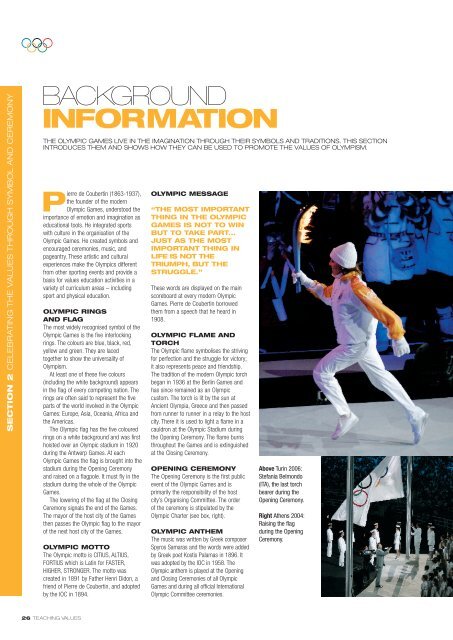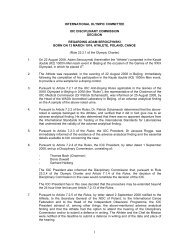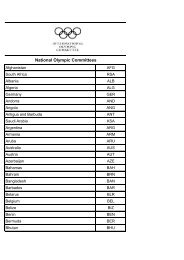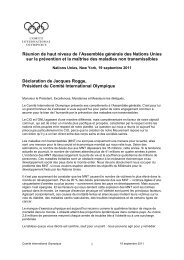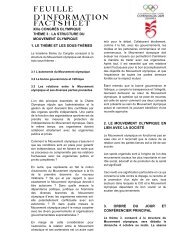Teaching Values- An Olympic Education Toolkit - International ...
Teaching Values- An Olympic Education Toolkit - International ...
Teaching Values- An Olympic Education Toolkit - International ...
Create successful ePaper yourself
Turn your PDF publications into a flip-book with our unique Google optimized e-Paper software.
SECTION 2 CELEBRATING THE VALUES THROUGH SYMBOL AND CEREMONY<br />
BACKGROUND<br />
INFORMATION<br />
THE OLYMPIC GAMES LIVE IN THE IMAGINATION THROUGH THEIR SYMBOLS AND TRADITIONS. THIS SECTION<br />
INTRODUCES THEM AND SHOWS HOW THEY CAN BE USED TO PROMOTE THE VALUES OF OLYMPISM.<br />
Pierre de Coubertin (1863-1937),<br />
the founder of the modern<br />
<strong>Olympic</strong> Games, understood the<br />
importance of emotion and imagination as<br />
educational tools. He integrated sports<br />
with culture in the organisation of the<br />
<strong>Olympic</strong> Games. He created symbols and<br />
encouraged ceremonies, music, and<br />
pageantry. These artistic and cultural<br />
experiences make the <strong>Olympic</strong>s different<br />
from other sporting events and provide a<br />
basis for values education activities in a<br />
variety of curriculum areas – including<br />
sport and physical education.<br />
OLYMPIC RINGS<br />
AND FLAG<br />
The most widely recognised symbol of the<br />
<strong>Olympic</strong> Games is the five interlocking<br />
rings. The colours are blue, black, red,<br />
yellow and green. They are laced<br />
together to show the universality of<br />
Olympism.<br />
At least one of these five colours<br />
(including the white background) appears<br />
in the flag of every competing nation. The<br />
rings are often said to represent the five<br />
parts of the world involved in the <strong>Olympic</strong><br />
Games: Europe, Asia, Oceania, Africa and<br />
the Americas.<br />
The <strong>Olympic</strong> flag has the five coloured<br />
rings on a white background and was first<br />
hoisted over an <strong>Olympic</strong> stadium in 1920<br />
during the <strong>An</strong>twerp Games. At each<br />
<strong>Olympic</strong> Games the flag is brought into the<br />
stadium during the Opening Ceremony<br />
and raised on a flagpole. It must fly in the<br />
stadium during the whole of the <strong>Olympic</strong><br />
Games.<br />
The lowering of the flag at the Closing<br />
Ceremony signals the end of the Games.<br />
The mayor of the host city of the Games<br />
then passes the <strong>Olympic</strong> flag to the mayor<br />
of the next host city of the Games.<br />
OLYMPIC MOTTO<br />
The <strong>Olympic</strong> motto is CITIUS, ALTIUS,<br />
FORTIUS which is Latin for FASTER,<br />
HIGHER, STRONGER. The motto was<br />
created in 1891 by Father Henri Didon, a<br />
friend of Pierre de Coubertin, and adopted<br />
by the IOC in 1894.<br />
OLYMPIC MESSAGE<br />
“THE MOST IMPORTANT<br />
THING IN THE OLYMPIC<br />
GAMES IS NOT TO WIN<br />
BUT TO TAKE PART...<br />
JUST AS THE MOST<br />
IMPORTANT THING IN<br />
LIFE IS NOT THE<br />
TRIUMPH, BUT THE<br />
STRUGGLE.”<br />
These words are displayed on the main<br />
scoreboard at every modern <strong>Olympic</strong><br />
Games. Pierre de Coubertin borrowed<br />
them from a speech that he heard in<br />
1908.<br />
OLYMPIC FLAME AND<br />
TORCH<br />
The <strong>Olympic</strong> flame symbolises the striving<br />
for perfection and the struggle for victory;<br />
it also represents peace and friendship.<br />
The tradition of the modern <strong>Olympic</strong> torch<br />
began in 1936 at the Berlin Games and<br />
has since remained as an <strong>Olympic</strong><br />
custom. The torch is lit by the sun at<br />
<strong>An</strong>cient Olympia, Greece and then passed<br />
from runner to runner in a relay to the host<br />
city. There it is used to light a flame in a<br />
cauldron at the <strong>Olympic</strong> Stadium during<br />
the Opening Ceremony. The flame burns<br />
throughout the Games and is extinguished<br />
at the Closing Ceremony.<br />
OPENING CEREMONY<br />
The Opening Ceremony is the first public<br />
event of the <strong>Olympic</strong> Games and is<br />
primarily the responsibility of the host<br />
city’s Organising Committee. The order<br />
of the ceremony is stipulated by the<br />
<strong>Olympic</strong> Charter (see box, right).<br />
OLYMPIC ANTHEM<br />
The music was written by Greek composer<br />
Spyros Samaras and the words were added<br />
by Greek poet Kostis Palamas in 1896. It<br />
was adopted by the IOC in 1958. The<br />
<strong>Olympic</strong> anthem is played at the Opening<br />
and Closing Ceremonies of all <strong>Olympic</strong><br />
Games and during all official <strong>International</strong><br />
<strong>Olympic</strong> Committee ceremonies.<br />
Above Turin 2006:<br />
Stefania Belmondo<br />
(ITA), the last torch<br />
bearer during the<br />
Opening Ceremony.<br />
Right Athens 2004:<br />
Raising the flag<br />
during the Opening<br />
Ceremony.<br />
26 TEACHING VALUES


